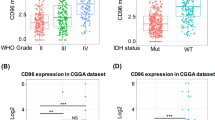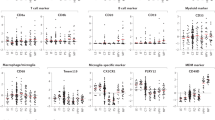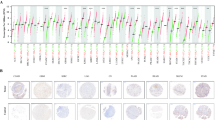Abstract
Focusing on highly specific aspects of the immune response is likely to answer a number of basic questions, and in some cases even resolve basic contradictions, in cancer immunology. For example, there are many cases, where chronic inflammation is associated with cancer development, and many other cases where an immune response represents an anticancer process. In this study, using bioinformatics algorithms, we examined the chemical relationships between the amino acid sequences of the complementarity-determining region-3 (CDR3) represented by immune receptors associated with lower grade glioma and isocitrate dehydrogenase-1 (IDH1) mutants. In particular, we developed a chemical complementarity scoring approach to classify tumors based on the complementarity of CDR3s and mutant IDH1 amino acids, relying on net charge per residue and hydropathy parameters. There was a strong correlation between the increased survival in low-grade glioma (LGG) and complementarity of IDH1 mutants to the CDR3 domain of the T-cell receptor beta chain (TRB). Similar results were obtained for TRB CDR3s and NRAS mutants in melanoma. Furthermore, the clear connection between increased survival rates and immune receptor-IDH1 mutant complementarities may also, partially, explain the better LGG prognosis for patients with IDH1 mutants.
This is a preview of subscription content, access via your institution
Access options
Subscribe to this journal
Receive 50 print issues and online access
$259.00 per year
only $5.18 per issue
Buy this article
- Purchase on Springer Link
- Instant access to full article PDF
Prices may be subject to local taxes which are calculated during checkout





Similar content being viewed by others
Code availability
References
Berghoff AS, Kiesel B, Widhalm G, Wilhelm D, Rajky O, Kurscheid S, et al. Correlation of immune phenotype with IDH mutation in diffuse glioma. Neuro Oncol. 2017;19:1460–8.
Chobrutskiy BI, Zaman S, Tong WL, Diviney A, Blanck G. Recovery of T-cell receptor V(D)J recombination reads from lower grade glioma exome files correlates with reduced survival and advanced cancer grade. J Neurooncol. 2018;140:697–704.
Davidson TB, Lee AH, Hsu M, Sedighim S, Orpilla J, Treger J, et al. Expression of PD-1 by T cells in malignant glioma patients reflects exhaustion and activation. Clin Cancer Res: Off J Am Assoc Cancer Res. 2018;25:1913–22.
Han S, Zhang C, Li Q, Dong J, Liu Y, Huang Y, et al. Tumour-infiltrating CD4(+) and CD8(+) lymphocytes as predictors of clinical outcome in glioma. Br J cancer. 2014;110:2560–8.
Cohen AL, Holmen SL, Colman H. IDH1 and IDH2 mutations in gliomas. Curr Neurol Neurosci Rep. 2013;13:345.
Mutant IDH1 is an effective immunotherapeutic target for Glioma Cancer Discov September 1 2014;4(9), OF13-OF13, https://doi.org/10.1158/2159-8290.CD-RW2014-145.
Schumacher T, Bunse L, Pusch S, Sahm F, Wiestler B, Quandt J, et al. A vaccine targeting mutant IDH1 induces antitumour immunity. Nature. 2014;512:324–7.
Dutoit V, Migliorini D, Ranzanici G, Marinari E, Widmer V, Lobrinus JA, et al. Antigenic expression and spontaneous immune responses support the use of a selected peptide set from the IMA950 glioblastoma vaccine for immunotherapy of grade II and III glioma. Oncoimmunology. 2018;7:e1391972.
Kimura H, Cook R, Meek K, Umeda M, Ball E, Capra JD, et al. Sequences of the VH and VL regions of murine monoclonal antibodies against 3-fucosyllactosamine. J Immunol. 1988;140:1212–7.
Tsuchiya Y, Namiuchi Y, Wako H, Tsurui H. A study of CDR3 loop dynamics reveals distinct mechanisms of peptide recognition by T-cell receptors exhibiting different levels of cross-reactivity. Immunology. 2018;153:466–78.
Zhou CY, Wang RN, Wen Q, He WT, Zhang SM, Du XL, et al. Alanine mutagenesis in the complementarity determining region 3 of the MTB and HIV-1 peptide-bispecific T cell receptor beta chain affects ligand recognition. Front Immunol. 2017;8:983.
Chobrutskiy BI, Zaman S, Diviney A, Mihyu MM, Blanck G. T-cell receptor-alpha CDR3 domain chemical features correlate with survival rates in bladder cancer. J cancer Res Clin Oncol. 2018;145:615–23.
Gros A, Parkhurst MR, Tran E, Pasetto A, Robbins PF, Ilyas S, et al. Prospective identification of neoantigen-specific lymphocytes in the peripheral blood of melanoma patients. Nat Med. 2016;22:433–8.
Roca AM, Chobrutskiy BI, Callahan BM, Blanck G. T-cell receptor V and J usage paired with specific HLA alleles associates with distinct cervical cancer survival rates. Hum Immunol. 2019;80:237–42.
Holehouse AS, Das RK, Ahad JN, Richardson MO, Pappu RV. CIDER: resources to analyze sequence-ensemble relationships of intrinsically disordered proteins. Biophys J. 2017;112:16–21.
Tong WL, Callahan BM, Tu YN, Zaman S, Chobrutskiy BI, Blanck G. Immune receptor recombinations from breast cancer exome files, independently and in combination with specific HLA alleles, correlate with better survival rates. Breast cancer Res Treat. 2018;173:167–77.
Zaman S, Chobrutskiy BI, Patel JS, Callahan BM, Tong WL, Mihyu MM, et al. MMP7 sensitivity of mutant ECM proteins: An indicator of melanoma survival rates and T-cell infiltration. Clin Biochem. 2018;63:85–91.
Zaman S, Chobrutskiy BI, Patel JS, Callahan BM, Tong WL, Blanck G. Mutant cytoskeletal and ECM peptides sensitive to the ST14 protease are associated with a worse outcome for glioblastoma multiforme. Biochemical biophysical Res Commun. 2018;503:2218–25.
Chobrutskiy BI, Zaman S, Tong WL, Diviney A, Blanck G. Recovery of T-cell receptor V(D)J recombination reads from lower grade glioma exome files correlates with reduced survival and advanced cancer grade. J Neurooncol. 2018;140:697–704.
Chen WW, Balaj L, Liau LM, Samuels ML, Kotsopoulos SK, Maguire CA, et al. BEAMing and droplet digital PCR analysis of mutant IDH1 mRNA in glioma patient serum and cerebrospinal fluid extracellular vesicles. Mol Ther Nucleic Acids. 2013;2:e109.
Kiviniemi A, Gardberg M, Frantzen J, Parkkola R, Vuorinen V, Pesola M, et al. Serum levels of GFAP and EGFR in primary and recurrent high-grade gliomas: correlation to tumor volume, molecular markers, and progression-free survival. J Neurooncol. 2015;124:237–45.
Syed P, Gupta S, Choudhary S, Pandala NG, Atak A, Richharia A, et al. Autoantibody profiling of glioma serum samples to identify biomarkers using human proteome arrays. Sci Rep. 2015;5:13895.
Zhang J, Xu Z, Yu L, Chen M, Li K. Assessment of the potential diagnostic value of serum p53 antibody for cancer: a meta-analysis. PloS one. 2014;9:e99255.
Thorsson V, Gibbs DL, Brown SD, Wolf D, Bortone DS, Ou Yang TH, et al. The immune landscape of cancer. Immunity. 2018;48:812–30 e814.
Leu S, von Felten S, Frank S, Vassella E, Vajtai I, Taylor E, et al. IDH/MGMT-driven molecular classification of low-grade glioma is a strong predictor for long-term survival. Neuro Oncol. 2013;15:469–79.
Metellus P, Coulibaly B, Colin C, de Paula AM, Vasiljevic A, Taieb D, et al. Absence of IDH mutation identifies a novel radiologic and molecular subtype of WHO grade II gliomas with dismal prognosis. Acta Neuropathol. 2010;120:719–29.
Mauro JA, Blanck G. Functionally distinct gene classes as bigger or smaller transcription factor traps: a possible stochastic component to sequential gene expression programs in cancer. Gene. 2014;536:398–406.
Mauro JA, Butler SN, Ramsamooj M, Blanck G. Copy number loss or silencing of apoptosis-effector genes in cancer. Gene. 2015;554:50–57.
Mauro JA, Yavorski JM, Blanck G. Stratifying melanoma and breast cancer TCGA datasets on the basis of the CNV of transcription factor binding sites common to proliferation- and apoptosis-effector genes. Gene. 2017;614:37–48.
Fisler DA, Sikaria D, Yavorski JM, Tu YN, Blanck G. Elucidating feed-forward apoptosis signatures in breast cancer datasets: Higher FOS expression associated with a better outcome. Oncol Lett. 2018;16:2757–63.
Sikaria D, Tu YN, Fisler DA, Mauro JA, Blanck G. Identification of specific feed-forward apoptosis mechanisms and associated higher survival rates for low grade glioma and lung squamous cell carcinoma. J cancer Res Clin Oncol. 2018;144:459–68.
Zaman S, Chobrutskiy BI, Sikaria D, Blanck G. MAPT (Tau) expression is a biomarker for an increased rate of survival for lowgrade glioma. Oncol Rep. 2019;41:1359–66.
Chen G, Yang X, Ko A, Sun X, Gao M, Zhang Y, et al. Sequence and structural analyses reveal distinct and highly diverse human CD8(+) TCR repertoires to immunodominant viral antigens. Cell Rep. 2017;19:569–83.
Yin Q, Tan H, Chen S, Yang L, Ye J, Li Y. Characterization of conserved CDR3 sequence of TCR alpha- and beta-chain genes in peripheral blood T-cells from patients with diffuse large B-cell lymphoma. Hematology. 2010;15:48–57.
You Z, Shi XB, DuRaine G, Haudenschild D, Tepper CG, Lo SH, et al. Interleukin-17 receptor-like gene is a novel antiapoptotic gene highly expressed in androgen-independent prostate cancer. Cancer Res. 2006;66:175–83.
Acknowledgements
Authors thank USF research computing and the taxpayers of the State of Florida. BIC, SZ, SF, MY and AD were recipients of USF Morsani College of Medicine RISE fellowships.
Author information
Authors and Affiliations
Corresponding author
Ethics declarations
Conflict of interest
The authors declare that they have no conflict of interest.
Additional information
Publisher’s note Springer Nature remains neutral with regard to jurisdictional claims in published maps and institutional affiliations.
Supplementary information
Rights and permissions
About this article
Cite this article
Chobrutskiy, B.I., Yeagley, M., Tipping, P. et al. Chemical complementarity between immune receptor CDR3s and IDH1 mutants correlates with increased survival for lower grade glioma. Oncogene 39, 1773–1783 (2020). https://doi.org/10.1038/s41388-019-1101-2
Received:
Revised:
Accepted:
Published:
Issue Date:
DOI: https://doi.org/10.1038/s41388-019-1101-2
This article is cited by
-
IGL CDR3 Hydropathy and Antigen Chemical Complementarity Associated with Greater Disease-Free Survival in Lung Adenocarcinoma: Implications for Gender Disparities
Biochemical Genetics (2024)
-
Exploiting big data survival information to unify risk-stratification related, adaptive immune receptor parameters for multiple myeloma
Genes & Immunity (2023)
-
Adaptive immune receptor features related to breast cancer tissue in Kenyan patients: high immunoglobulin gene expression and high levels of gamma-delta T-cells
Breast Cancer Research and Treatment (2023)
-
Delineation of a T-cell receptor CDR3-cancer mutanome aromaticity factor, assessable via blood samples, that facilitates the establishment of survival distinctions in bladder cancer
Journal of Cancer Research and Clinical Oncology (2023)
-
Tumor Resident, B-Cell Receptor Chemical Characteristics Associated with Better Overall Survival for Neuroblastoma
Journal of Molecular Neuroscience (2022)



